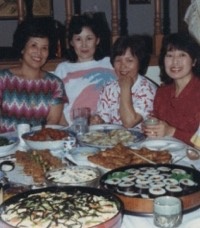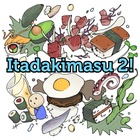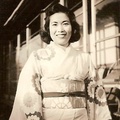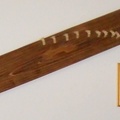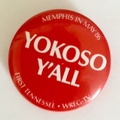In the documentary film Fall Down Seven Times, Get Up Eight: The Japanese War Brides, Hiroko Tolbert says, “I’m completely American.” Her daughter Kathryn counters, “You know, it’s funny to say how American you are, yet every morning you make miso soup.” Hiroko giggles, “Well, the food is a different story,” she says, and she and her daughter both laugh…and it is.
As we grow older, it seems, my best friend Brenda and I talk about food often. We are the daughters of Japanese war bride mothers and American fathers who were born and raised in the South. Just as Japan has its own unique cuisine, so too, do Southerners, who are very proud of foods we deem as Southern, like fried chicken, barbecue, turnip greens, and cornbread, just to name a few.
My mom was a graduate of the American Red Cross “bride school” in Yokohama. These classes were established to help the thousands of Japanese women who wed American soldiers in the aftermath of World War II become familiar with the American way of life as they prepared to immigrate to the U.S. with their husbands.
My mom passed away nearly 20 years ago, but I remember her telling me she learned to make pineapple upside-down cake and fried chicken at bride school. After she and my dad married, they spent several years living in Japan before coming to the U.S. She remembered the first time she invited her father (my grandfather) to their home for an American meal. She made fried chicken for dinner, and recalled that my grandfather, a tough, taskmaster born in the Meiji era (1868–1912), declared it the best meal he had ever tasted. His overwhelming approval made my mom very proud and happy.
As children, like our bi-cultural Hapa heritage, Brenda and I grew up eating a mix of quintessentially American, some decidedly Southern, and Japanese foods. We both remember eating egg rice a lot. Egg rice is a raw egg, soy sauce, and a sprinkle of ajinomoto (MSG) mixed together with hot, steamed rice, creating a sort of porridge. We both loved it as children, but haven’t eaten it in years, probably because of a fear of salmonella from the raw egg.
Growing up, both of our mothers often cooked an American meal, a meat and two sides, for us and our dads, and then prepared Japanese food for themselves. Dinner was usually gohan (steamed rice) and some type of cooked fish (sakana), with pickles (tsukemono). On those occasions when our moms would cook a Japanese meal for the whole family, the hands-down favorite of our dads, and us, too, was sukiyaki (simmered beef, vegetables, and noodles) in a broth, cooked in the center of the table and served with rice. The thin, clear noodles were truly the best part of the meal when we were kids. We’d sometimes get scolded for picking most of them out the pan and eating them all.
My mom learned how to make Southern staples like turnip greens, cornbread, and fried okra from a cadre of great Southern cooks on my dad’s side of the family that included my mamaw (grandmother) and a long line of aunts. In Brenda’s family, it was her dad who taught her mom how to cook these same dishes.
The celebration of holidays such as the Fourth of July often brought the two cultures together with ribs cooked on the grill, served alongside Japanese-style egg rolls or sushi.
While any Japanese or Southern “blue-plate” restaurant serving a traditional meat and two or three offer opportunities to curb cravings for either cuisine, Brenda and I agree, nothing beats homemade. And for us, this is especially true of futomaki. In both our households, vegetable futomaki was the standard. We don’t remember either of our mothers including fish in the sushi rolls of vinegared and sugared rice and seaweed. Most often, homemade futomaki included the Japanese-style sweet egg omelet, blanched spinach, cucumber, marinated carrot, beni shoga (ginger), and kanpyo. I don’t know how to describe kanpyo except the way that we always have, since we were kids, “the brown stuff in the sushi.”
My mom was a master of futomaki. It was her dish to make and share whenever there were gatherings of her Japanese friends for special lunches, dinners, or New Year celebrations. She also made nigiri sushi, and these were mostly vegetable, too, with spinach or egg, and on very special occasions cooked shrimp on top of small mounds of rice, but her go-to dish was futomaki.
We had a beagle when I was growing up. One year, my mom had prepared a beautiful table filled with both futomaki and nigiri sushi for a pre-New Year celebration with her friends. My mom and I were in another part of the house, only to come back into the kitchen to find our beagle standing on the dining room table eating all of the shrimp off of her beautiful nigiri sushi. My mom was livid! Our dog survived…but, just barely.
Brenda’s mom, who is 84, is still a futomaki master. Several years ago, Brenda’s dad was in the hospital. Brenda and I stopped by the hospital on our way home from work to check on him. Her mom arrived shortly thereafter. We all visited for a while, then her mom realized she had brought Brenda’s dad a treat in her handbag. It was a futomaki! Wrapped in plastic wrap and aluminum foil, it was fresh, and the rice was cooked and seasoned perfectly. It was a lovely surprise, shared between all four of us, and it was absolutely delicious.
As children and as adults, Brenda and I both had opportunities to visit Japan with our moms as children in the ’70s and as adults in the ’80s and ’90s.
Staying with her grandmother in Osaka in 1970, Brenda says there was no American food. She remembers eating a lot of kappa maki cucumber sushi. At age 11, everything was foreign and strange. She recalls being excited when her family decided to go to a baseball game. She was expecting baseball food, like hotdogs…what she got instead was takoyaki, or octopus on a stick.
When her family went to Expo ’70 in Osaka, Brenda was overjoyed to learn the first Kentucky Fried Chicken in Japan was located there. She devoured the fried chicken, and she couldn’t believe it when her Japanese family was not impressed, and didn’t do the same.
In 1974, at age 13, I remember walking in my uncle’s neighborhood in Osaka and discovering a vending machine that dispensed ramen “Cup Noodles.” I’d never seen anything like it, and was thrilled to be able to put some yen in the machine and take one home to eat. I went back to that vending machine almost every day during our visit.
I am not the best cook, but can make my mother’s from-scratch recipe for pineapple upside-down cake and carry a dish of baked beans or sweet potato casserole to a family gathering or church potluck, thanks to recipes shared by my Southern aunts. As far as Japanese food goes, I can make curry with the help of House Vermont Curry roux cubes, and my favorite dish to make is a simple one, green beans with sesame seeds, one that my mom made often, and Brenda’s mom helped me learn.
Brenda is the chef between the two of us. She makes an awesome chicken and dressing (we refer to stuffing as dressing in the South) and chocolate pies with lovely, high, sculpted meringues. Recipes handed down from her Southern mother-in-law. Brenda also makes wonderful sausage gravy. For several Sundays when my dad was under hospice care near the end of his life, Brenda would bring him sausage gravy and biscuits to cheer him and soothe his Southern soul.
Brenda’s mom taught her how to make gyoza, and she in turn taught her husband and I how to stuff and fold them as she pan fries/steams them. I’m a bit embarrassed to say that on one “gyoza night” at Brenda’s home we made and feasted on 80 tasty gyoza dumplings between the three of us!
As an adult in Japan, both my mom and I loved browsing through the basements of department stores throughout Tokyo, which feature almost anything you could possibly want to eat, from beautiful obentos (take-away meals) of all types to gorgeous fruits and pastries. In Osaka, as an adult, Brenda developed a fondness for okonomiyaki, a Japanese-style savory pancake. She says it’s her favorite Japanese food. Brenda’s mom recently asked her what Japanese food she would like for her to make while she is still able, and the answer of course, was okonomiyaki.
Clearly, food is one element that serves to define a culture. For Brenda and I, who consider ourselves half-Southern and half-Japanese, whether it’s ribs or ramen, or fried chicken or futomaki, we’re always ready to say let’s eat or itadakimasu!
© 2017 Linda Cooper



